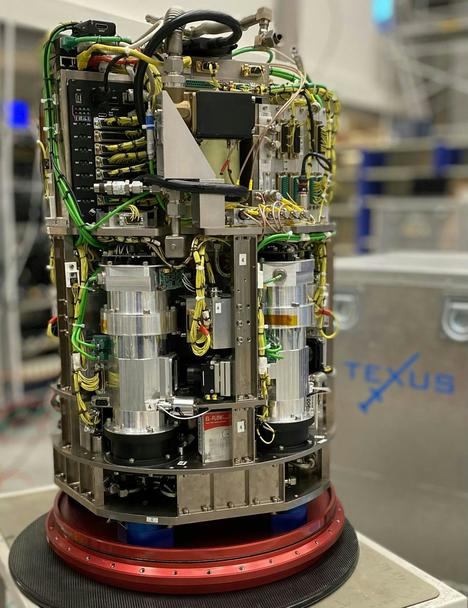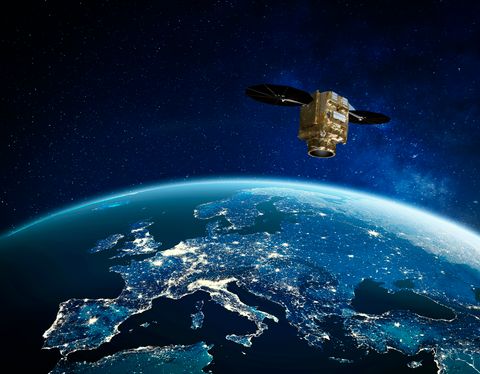Airbus-built TEXUS sounding rockets take to the skies to conduct experiments in microgravity

Great discoveries may start with these little experiments
TEXUS 59 & 60 successively and successfully launched in less than two months
The TEXUS 60 rocket was successfully launched on Sunday 24 March, at 10:45 CET, from Esrange Space Centre in Kiruna, Sweden. The rocket reached an apogee of 251 km and provided 362 seconds of microgravity time. The payloads on board included two DLR experiments for the German Aerospace Center (DLR), called Simona and GECO, as well as a joint experiment of DLR and the Japanese Space Agency JAXA, called Phoenix 2.
During a microgravity time period of six minutes, Simona performed an experiment to study specific reactions of liquid alloys in microgravity to enhance advanced materials for car engine bearings, while GECO recorded calcium interaction with microgravity in plants to expand our knowledge about plant cultivation to ensure, for instance, a food source in space. Finally, Phoenix 2 got deeper into droplet interaction in spontaneous ignition of multiple fuel droplets that will lead to a better understanding of liquid spray combustion which is employed in industrial furnaces, boilers, gas turbines, diesels, spark-ignition, and rocket engines.
Previously, the TEXUS 59 rocket was successfully launched from Esrange on 15 February carrying two ESA experiments, Safari and T-REX , and one DLR experiment, Topoflame, on board.
Safari, for example, aimed to study the growth of crystals that can lead to improvements in drug development to better understand the function of molecules that are important in health and disease, and agricultural solutions that better protect crops and enhance plant growth on Earth. T-REX, studying different behaviour of immune system cells under microgravity. Its findings could help to understand the biological process that allows a cell or an organism to respond to a variety of signals since this is one of the leading causes in various human diseases. More than fifty percent of cancers arise due to frequent mutations in genes.
The last experiment aboard TEXUS 59 was Topoflame, aimed to understand the insights of fire safety in astronautical spaceflight, studying flame propagation along solid fuels. Planned space exploration missions raise concerns about fire safety and propagation under conditions of reduced gravity.
These launches represent a double success generating an enormous amount of data to support scientists.
Airbus as prime contractor for TEXUS
Airbus is in charge of the development of the TEXUS rockets, from the mission concept and engine procurement to the data recovery. The average weight of a TEXUS payload is around 350 kg.
Airbus engineers from different disciplines develop, integrate and test the experimental equipment. In collaboration with customers and scientific teams, they establish experimental concepts. Breadboard tests are conducted to support design decisions. Depending on the results, further tests may be required to determine or verify critical parameters of the experiment before launch. Design reviews with customers ensure that their requirements are fully met.
Finally, the experimental equipment is integrated, tested at various stages and verified. All this goes hand-in-hand with the development of the ground support systems needed to control the experiments during the test phase in Bremen and during the flight from Esrange.
Before transferring all flight hardware and ground systems to Esrange, a flight system acceptance review is organised with customers, which also covers the contributions of subcontractors: the service system (communication between the experiments and the ground station), the recovery system (parachutes), the rocket engines (solid propellant) and the readiness of the facilities at Esrange.

Reduced volume makes payload more complex - Copyright Airbus
What is at stake?
Sounding rockets – also known as research rockets – launch scientific and technological experiments to the edge of space before falling back to Earth. Put simply, TEXUS helps scientists conduct biological, material science and physical experiments under microgravity conditions. The programme also plays an important role in preparing experiments for the International Space Station (ISS).
In ballistic flight, a TEXUS rocket reaches a peak altitude of about 260 kilometres. The flight, from lift-off to landing, takes about 15 minutes. As it falls freely, the experiments inside experience weightlessness for a duration of six minutes, which is only about one ten thousandth of the Earth’s normal gravity. During these six minutes of valuable research time, the scientists can directly control and monitor their experiments from the ground using telecommand and video transmission. The data is collected during the flight by telemetry and after recovery of the payload. The rocket’s payload lands by parachute and is recovered by helicopter with the support of Airbus and the Swedish Space Corporation, Esrange’s operator.
In gravitational biology, for instance, the role of gravity for cellular growth, development, reproduction, movement, orientation and other physiological processes, as well as the mechanisms of adaptation and compensation, are investigated. In bioprocessing, cell fusion and cell cultivation techniques are investigated. Also, growth of high-quality monocrystals of biological macromolecules for crystal structure analysis; or rapid technological processes such as electrophoresis and electrofusion can be performed. These are only some of the research areas studied that ultimately translate into tangible benefits for society.
The advantages of sounding rockets
Mission costs are substantially less than those required for orbital missions
Since they never enter orbit, they do not require extreme propulsion or telemetry and tracking coverage. The costs of the rocket are shared between 2, 3 or 4 research centres that provide their experiments. In addition, they serve as a test bed for future innovations that will go on board satellites or even the Space Station.
Rapid availability from conception to flight
The payload can be developed in a very short time frame of 6 to 18 months. Moreover, with such a short development time, the latest technology can be incorporated into its experiments. It also offers a very fast response capability, e.g. to arrive in time to study cosmological phenomena, such as the effects of an extreme solar flare on the auroras' behaviour.
Direct involvement
Investigators are directly involved in developing the hardware, and in the preparation and execution of the experiment. Remote operation of the experiment can be done directly by the scientist during flight via telecommand and the support of adequate laboratory facilities at the launch site.
Support of orbital research
Sounding rockets offer the possibility of conducting a series of periodical investigations for rapid verification of data used to prepare experiments that will later be implemented on the ISS.
TEXUS (Technological Experiments in Zero Gravity) is the world's most successful and longest lasting sounding rocket programme – the first TEXUS rocket launched in December 1977. Customers include the European Space Agency and the German Aerospace Center (DLR) working together with various research institutes and universities around the world.
Your contact
Ralph Heinrich
AIRBUS | Defence and Space
Jeremy Close
AIRBUS | Defence and Space
Guilhem Boltz
AIRBUS | Defence and Space
Francisco Lechón
External Communications - Airbus Space Systems, Spain



